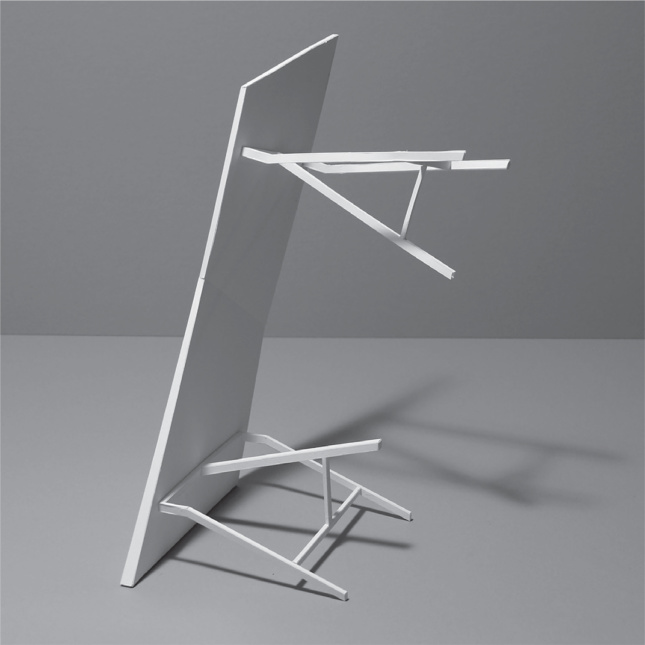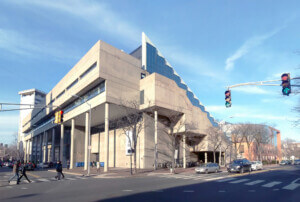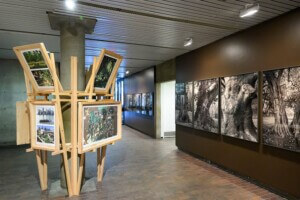Possible Mediums
Edited by Kelly Bair, Kristy Balliet, Adam Fure, and Kyle Miller
Actar
$34.95 MSRP
Possible Mediums, a volume edited by four xennial American architecture professors, documents the formal experimentation of the recent post-digital turn in architecture. The book glimpses a generation paradoxically invested in using obscure methods to make charismatic forms. Unlike other postmodern camps (pomo, deconstructivism, parametricism), this generation eschews stylistic cohesion, instead claiming diversity and eclecticism as its hallmark. Inspired by philosopher Michel Foucault’s reading of a fictional Chinese encyclopedia in The Order of Things (the incoherence of which undermines Western epistemology itself), Possible Mediums’ preface essay, “Notes from the Middle,” relishes pluralism and how “the delightfully weird work of…colleagues challenged preconceived notions of order.” However, by deliberately withholding a theoretical framework, the editors leave their uninitiated readers to wonder whether the volume marks a new architectural movement or is simply a yearbook filled with the signatures of well-wishing friends. Whether Possible Mediums is a yearbook or Oriental arcana, the book’s format is infectious and invites casual, nonlinear, and occasional reading. In the same spirit of the volume’s meandering musings, this review will proceed as a loose collection of entries.

#71
Arguing for strength in numbers, this volume is full of them. The editors treat their own numbers as a conceptual argument, noting, “We began as a group of four, but quickly grew to 16, then to 25, and now have over 40 project contributors…” They could go on: John McMorrough’s six examples of architectural mediums explicitly numbered, 71 total projects, 16 jam-packed guest essays, 16 mediums [sic], 18 paper stocks, etc. The editors claim, “Possible Mediums is not a systematic theory, a manifesto, or banal survey—it is a projection of architecture and knowledge to come.” And in the absence of knowledge per se, quantity becomes quality. A slow reading might go something like this: The book contains 71 projects, a number sufficiently large, indicating something historic underfoot. Moreover, 71 seems sufficiently precise, an irreducible prime number, the inelegance of which also suggests that there can neither be more nor less, neither 70 nor 72. In sum, 71 is an architectural movement, at once historical, irreducible, and singular.
Listicle
Beginning with the editors’ reference to Foucault’s Chinese encyclopedia, this book continues to make happy use of lists throughout. Along with lists of paper stocks, architectural media, and guest essays, there are lists of influential UCLA faculty, supply stores, types of sandwiches, questions for readers to ask themselves, etc. The explicit use of lists by both the editors and contributors is reminiscent of the proliferation of useless content on the internet, necessitating the novel curation of listicles as a new literary genre. We now revel in the veneration of tiny, insignificant yet common phenomena. In the post-internet age, architecture defers to everyday non-architectural objects, high and low, from CAD Blocks to Google’s 3-D Warehouse. These things are all worthy of appropriation in the process of making new forms.

Debris
Flipping through the book, there’s a lot of debris. Some of it is more like piles, rubble, clutter, junk, or ruins, depending on which page you land on. The volume’s insistence on including so many different types of debris makes one think that there is something important about this seemingly unimportant form. In fact, these architects are much more interested in architecture as things rather than forms. Most of their projects look like they are in disuse—things that are falling apart, recycled, decomposing, and on their backsides. Perhaps in reaction to the pageantry of elegant and hyper-engineered surfaces of the digital age, debris ushers in a new cycle of decomposition to architectural discourse. However, unlike the previous antagonism and violence of deconstructivism, debris is more casual, informal, and nonchalant. According to the architects, debris has a purpose: It disrupts part-to-whole relations, celebrates ambiguity, and elevates the ordinary.
Inconclusive
Like their digital predecessors, this group is invested in formal complex exuberance. Unlike their precursors, this crew is invested in the misappropriation of citations and readymades to such a degree that disciplinary norms and hierarchies are overturned. Such preoccupations, however, are never explicitly acknowledged, and adopt a thinglike quality. Once noted, this degree of thingness becomes an index of contemporaneity: The 2000s are malleable, diagrammatic, and morphological, while the mid-to-late 2010s are full of referential things in semi-disarray. To an outsider, this shift may feel solipsistic and inconsequential—but make no mistake, this generation is distrustful of formal mastery, and instead agnostically embraces the detritus of what’s left of meaning. Nothing is taken for granted, and every thing is worked on as a medium of inquiry. For architecture, this novelty is not only formal, but also etymological in an intriguing, almost imperceptible, way.
Max Kuo designs with ALLTHATISSOLID and teaches at Harvard Graduate School of Design.











